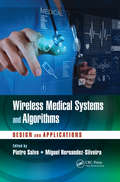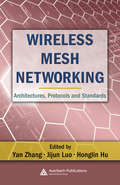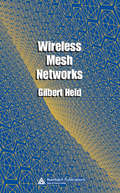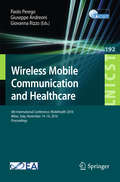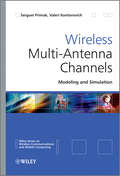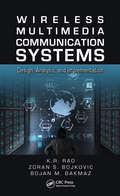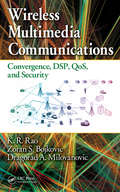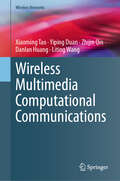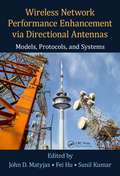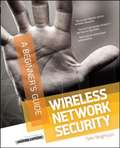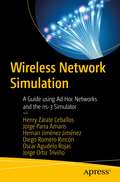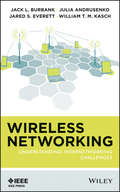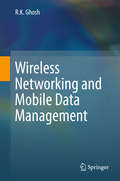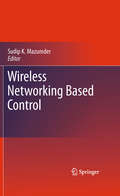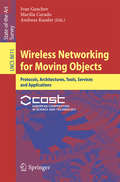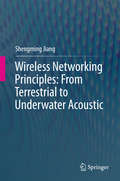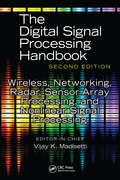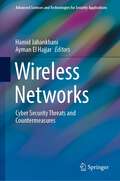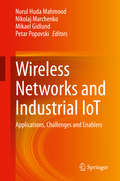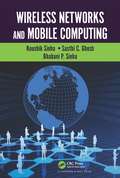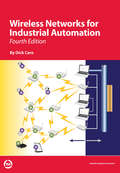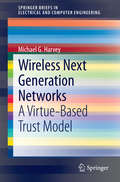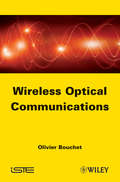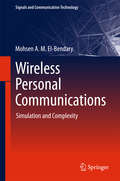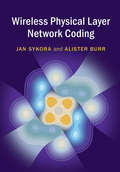- Table View
- List View
Wireless Medical Systems and Algorithms: Design and Applications (Devices, Circuits, and Systems #56)
by Pietro Salvo Miguel Hernandez-SilveiraWireless Medical Systems and Algorithms: Design and Applications provides a state-of-the-art overview of the key steps in the development of wireless medical systems, from biochips to brain–computer interfaces and beyond. The book also examines some of the most advanced algorithms and data processing in the field. Addressing the latest challenges and solutions related to the medical needs, electronic design, advanced materials chemistry, wireless body sensor networks, and technologies suitable for wireless medical devices, the text: Investigates the technological and manufacturing issues associated with the development of wireless medical devices Introduces the techniques and strategies that can optimize the performances of algorithms for medical applications and provide robust results in terms of data reliability Includes a variety of practical examples and case studies relevant to engineers, medical doctors, chemists, and biologists Wireless Medical Systems and Algorithms: Design and Applications not only highlights new technologies for the continuous surveillance of patient health conditions, but also shows how disciplines such as chemistry, biology, engineering, and medicine are merging to produce a new class of smart devices capable of managing and monitoring a wide range of cognitive and physical disabilities.
Wireless Mesh Networking: Architectures, Protocols and Standards (Wireless Networks and Mobile Communications)
by Yan Zhang Jijun Luo Honglin HuA promising new technology, wireless mesh networks are playing an increasingly important role in the future generations of wireless mobile networks. Characterized by dynamic self-organization, self-configuration, and self-healing to enable quick deployment, easy maintenance, low cost, high scalability, and reliable services, this technology is beco
Wireless Mesh Networks
by Gilbert HeldWireless mesh networking is a new technology that has the potential to revolutionize how we access the Internet and communicate with co-workers and friends. Wireless Mesh Networks examines the concept and explores its advantages over existing technologies. This book explores existing and future applications.
Wireless Mobile Communication and Healthcare
by Paolo Perego Giuseppe Andreoni Giovanna RizzoThis book constitutes the refereed post-conference proceedings of the 6th International Conference on Mobile Communication and Healthcare, MobiHealth 2016, held in Milan, Italy, in November 2016. The 50 revised full papers were reviewed and selected from numerous submissions and are organized in topical sections covering: Technological development for m-health application user engagement. - IoT - Internet of Things. - Advances in soft wearable technology for mobile-health. - Emerging experiences into receiving and delivering healthcare through mobile and embedded solutions. - Advances in personalized healthcare services. - Mobile monitoring, and social media pervasive technologies.
Wireless Multi-Antenna Channels
by Serguei Primak Valeri KontorovichThis book offers a practical guide on how to use and apply channel models for system evaluationIn this book, the authors focus on modeling and simulation of multiple antennas channels, including multiple input multiple output (MIMO) communication channels, and the impact of such models on channel estimation and system performance. Both narrowband and wideband models are addressed. Furthermore, the book covers topics related to modeling of MIMO channel, their numerical simulation, estimation and prediction, as well as applications to receive diversity, capacity and space-time coding techniques.Key Features:Contains significant background material, as well as novel research coverage, which make the book suitable for both graduate students and researchersAddresses issues such as key-hole, correlated and non i.i.d. channels in the frame of the Generalized Gaussian approachProvides a unique treatment of generalized Gaussian channels and orthogonal channel representationReviews different interpretations of scattering environment, including geometrical modelsFocuses on the analytical techniques which give a good insight into the design of systems on higher levelsDescribes a number of numerical simulators demonstrating the practical use of this material.Includes an accompanying website containing additional materials and practical examples for self-studyThis book will be of interest to researchers, engineers, lecturers, and graduate students.
Wireless Multimedia Communication Systems: Design, Analysis, and Implementation
by K.R. Rao Zoran S. Bojkovic Bojan M. BakmazRapid progress in software, hardware, mobile networks, and the potential of interactive media poses many questions for researchers, manufacturers, and operators of wireless multimedia communication systems. Wireless Multimedia Communication Systems: Design, Analysis, and Implementation strives to answer those questions by not only covering the underlying concepts involved in the design, analysis, and implementation of wireless multimedia communication systems, but also by tackling advanced topics such as mobility management, security components, and smart grids. Offering an accessible treatment of the latest research, this book: Presents specific wireless multimedia communication schemes that have proven to be useful Discusses important standardization processing activities regarding wireless networking Includes wireless mesh and multimedia sensor network architectures, protocols, and design optimizations Highlights the challenges associated with meeting complex connectivity requirements Contains numerous figures, tables, examples, references, and a glossary of acronyms Providing coverage of significant technological advances in their initial steps along with a survey of the fundamental principles and practices, Wireless Multimedia Communication Systems: Design, Analysis, and Implementation aids senior-level and graduate-level engineering students and practicing professionals in understanding the processes and furthering the development of today’s wireless multimedia communication systems.
Wireless Multimedia Communications: Convergence, DSP, QoS, and Security
by K.R. Rao Zoran S. Bojkovic Dragorad A. MilovanovicWith the rapid evolution of multimedia communications, engineers and other professionals are generally forced to hoard a plethora of different texts and journals to maintain a solid grasp on essential ideas and techniques in the field. Wireless Multimedia Communications provides researchers and students with a primary reference to help readers take maximum advantage of current systems and uncover opportunities to propose new and novel protocols, applications, and services. Extract the Essentials of System Design, Analysis, ImplementationA complete technical reference, the text condenses the essential topics of core wireless multimedia communication technologies, convergence, QoS, and security that apply to everything from networking to communications systems, signal processing, and security. From extensive existing literature, the authors distill the central tenets and primary methods of analysis, design, and implementation, to reflect the latest technologies and architectural concepts. The book addresses emerging challenges to inform the system standardization process and help engineers combat the high error rates and stringent delay constraints that remain a significant challenge to various applications and services. Keep Pace with Detailed Techniques to Optimize TechnologyThe authors identify causes of information loss in point-to-point signal transmission through wireless channels, and then they discuss techniques to minimize that loss. They use examples that illustrate the differences in implementing various systems, ranging from cellular voice telephony to wireless Internet access. Each chapter has been carefully organized with the latest information to serve dual purposes as an easy-to-reference guide for professionals and as a principal text for senior-level university students.
Wireless Multimedia Computational Communications (Wireless Networks)
by Xiaoming Tao Yiping Duan Zhijin Qin Danlan Huang Liting WangThis book discusses the evolving designs and applications of multimedia content delivery and focuses on computing-based methods. It offers readers an in-depth understanding of how computational resources at both the source and the destination of the networking continuum can be exploited. This enhances the overall performance of multimedia data networking. This book also presents novel designs and applications focusing on information delivery based on computing. It starts with an overview of the multimedia computational communications as well as spanning topics. The topics range in experience evaluation using electroencephalography, semantic knowledge bases with the next generation of multiple access, end-to-end semantic communication framework and cloud-edge-end intelligent coordination computing. The authors believe this book offers readers a clear picture of the current state and the next steps in multimedia computational communication networks. Graduate students majoring in the areas of communication networks, computer science and engineering and electrical engineering will find this book useful as a secondary text or reference book. Professionals and researchers working in computational transmission solutions for multimedia communication networks will find this book to be a valuable resource as well.
Wireless Network Performance Enhancement via Directional Antennas: Models, Protocols, and Systems
by John D. Matyjas Fei Hu Sunil KumarDirectional antenna technologies have made significant advancements in the last decade. These advances have opened the door to many exciting new design opportunities for wireless networks to enhance quality of service (QoS), performance, and network capacity. In this book, experts from around the world present the latest research and development in
Wireless Network Security
by Brock Pearson Tyler WrightsonSecurity Smarts for the Self-Guided IT Professional Protect wireless networks against all real-world hacks by learning how hackers operate. "Wireless Network Security: A Beginner's Guide" discusses the many attack vectors that target wireless networks and clients--and explains how to identify and prevent them. Actual cases of attacks against WEP, WPA, and wireless clients and their defenses are included. This practical resource reveals how intruders exploit vulnerabilities and gain access to wireless networks. You'll learn how to securely deploy WPA2 wireless networks, including WPA2-Enterprise using digital certificates for authentication. The book provides techniques for dealing with wireless guest access and rogue access points. Next-generation wireless networking technologies, such as lightweight access points and cloud-based wireless solutions, are also discussed. Templates, checklists, and examples give you the hands-on help you need to get started right away. "Wireless Network Security: A Beginner's Guide" features: Lingo--Common security terms defined so that you re in the know on the job IMHO--Frank and relevant opinions based on the author's years of industry experience In Actual Practice--Exceptions to the rules of security explained in real-world contexts Your Plan--Customizable checklists you can use on the job now Into Action--Tips on how, why, and when to apply new skills and techniques at work "This is an excellent introduction to wireless security and their security implications. The technologies and tools are clearly presented with copious illustrations and the level of presentation will accommodate the wireless security neophyte while not boring a mid-level expert to tears. If the reader invests the time and resources in building a lab to follow along with the text, s/he will develop a solid, basic understanding of what "wireless security" is and how it can be implemented in practice. This is definitely a recommended read for its intended audience. " - Richard Austin, IEEE CIPHER, IEEE Computer Society's TC on Security and Privacy (E109, July 23, 2012) "
Wireless Network Simulation: A Guide using Ad Hoc Networks and the ns-3 Simulator
by Henry Zárate Ceballos Jorge Ernesto Parra Amaris Hernan Jiménez Jiménez Diego Alexis Romero Rincón Oscar Agudelo Rojas Jorge Eduardo Ortiz TriviñoLearn to run your own simulation by working with model analysis, mathematical background, simulation output data, and most importantly, a network simulator for wireless technology. This book introduces the best practices of simulator use, the techniques for analyzing simulations with artificial agents and the integration with other technologies such as Power Line Communications (PLC).Network simulation is a key technique used to test the future behavior of a network. It’s a vital development component for the development of 5G, IoT, wireless sensor networks, and many more. This book explains the scope and evolution of the technology that has led to the development of dynamic systems such as Internet of Things and fog computing. You'll focus on the ad hoc networks with stochastic behavior and dynamic nature, and the ns-3 simulator. These are useful open source tools for academics, researchers, students and engineers to deploy telecommunications experiments, proofs and new scenarios with a high degree of similarity with reality. You'll also benefit from a detailed explanation of the examples and the theoretical components needed to deploy wireless simulations or wired, if necessary.What You’ll LearnReview best practices of simulator usesUnderstand techniques for analyzing simulations with artificial agentsApply simulation techniques and experiment designProgram on ns-3 simulatorAnalyze simulation resultsCreate new modules or protocols for wired and wireless networksWho This Book Is ForUndergraduate and postgraduate students, researchers and professors interested in network simulations. This book also includes theoretical components about simulation, which are useful for those interested in discrete event simulation DES, general theory of simulation, wireless simulation and ns-3 simulator.
Wireless Networking: Understanding Internetworking Challenges
by Julia Andrusenko Jared S. Everett William T.M. Kasch Jack L. BurbankThis book focuses on providing a detailed and practical explanation of key existing and emerging wireless networking technologies and trends,while minimizing the amount of theoretical background information. <P><P>The book also goes beyond simply presenting what the technology is, but also examines why the technology is the way it is, the history of its development, standardization, and deployment. The book also describes how each technology is used, what problems it was designed to solve, what problems it was not designed to solve., how it relates to other technologies in the marketplace, and internetworking challenges faced withing the context of the Internet, as well as providing deployment trends and standardization trends. Finally, this book decomposes evolving wireless technologies to identify key technical and usage trends in order to discuss the likely characteristics of future wireless networks.
Wireless Networking and Mobile Data Management
by R. K. GhoshThis book examines two main topics, namely, Wireless Networking and Mobile Data Management. It is designed around a course the author began teaching to senior undergraduate and master's students at the Department of Computer Science & Engineering of the Indian Institute of Technology Kanpur. The first part of the book, consisting of eight chapters, including the introduction, focuses exclusively on wireless networking aspects. It begins with cellular communication systems, which provided the foundation of wireless networking principles. Three subsequent chapters are devoted to the Global System for Mobile communication (GSM), Wireless Local Area Network (WLAN), Bluetooth, infrared (IR), ZigBee and 6LoWPAN protocols. There is also a chapter on routings in ad hoc networks, an area that is currently being intensively researched due to its potential applications in areas of vehicular network, traffic management, tactical and military systems. Furthermore, the book discusses mobile operating systems and wireless network application level protocols such as Wireless Application Protocols (WAP), Mobile IP and Mosh. The second part highlights mobile data management. It addresses the issues like location management, the importance of replication and caching in mobile environments, the concept of broadcast disk and indexing in air, storage systems for sharing data in mobile environments, and building smart environments. Given that the design of algorithms is the key to applications in data management; this part begins with a chapter on the type of paradigm shift that has been introduced in the design of algorithms, especially due to asymmetry in mobile environments. Lastly, the closing chapter of the book explores smart environments, showing the readers how wireless technology and mobile data management can be combined to provide optimum comfort for human life. Though the book has been structured as a monograph, it can be used both as a textbook and as a reference material for researchers and developers working in the area.
Wireless Networking Based Control
by Sudip K. MazumderThis book will have a broad appeal in the area of Wireless Networking-Based Control. Various engineering disciplines, control and communication science organizations will be interested in purchasing the book with a new, emerging, and important theme. Also, industry such as Honeywell and those (e.g. power industry, automotive industry, aerospace industry) interested in implementing wireless network control to express interest in purchasing this book.
Wireless Networking for Moving Objects
by Ivan Ganchev Marília Curado Andreas KasslerWireless networks of moving objects have drawn significant attention recently. These types of networks consist of a number of autonomous or semi-autonomous wireless nodes/objects moving with diverse patterns and speeds while communicating via several radio interfaces simultaneously. To overcome current shortcomings, a number of research challenges have to be addressed in this area, ranging from initial conceptualization and modelling, to protocols and architectures engineering, and development of suitable tools, applications and services, and to the elaboration of realistic use-case scenarios by taking into account corresponding societal and economic aspects. By applying a systematic approach the objective of this book is to assess the state of the art and consolidate the main research results achieved in this area. It was prepared as the Final Publication of the COST Action IC0906 "Wireless Networking for Moving Objects (WiNeMO)". The book contains 15 chapters and is a show-case of the main outcomes of the action in line with its scientific goals. The book will serve as a valuable reference for undergraduate students, post-graduate students, educators, faculty members, researchers, engineers, and research strategists working in this field.
Wireless Networking Principles: From Terrestrial to Underwater Acoustic
by Shengming JiangThis book systematically summarizes the fundamentals and various technologies in both terrestrial radio wireless networks and underwater acoustic networks (UWANs). It addresses the basic issues frequently investigated in terrestrial radio wireless networks and the key technologies suitable for the newly developing research area of UWANs. Starting with a review of our current understanding of wireless networks, it then introduces the principles of the main technologies, including error control, medium access control (MAC) protocols, routing protocols, end-to-end transmission control and mobility issues as well as network security for terrestrial radio wireless networks, and offers detailed surveys of these technologies for UWANs.Providing readers with the basic knowledge of terrestrial radio wireless networking technologies and raising readers’ awareness of the developing topic of UWANs in ocean , it is a valuable resource for researchers and practitioners in terrestrial radio wireless networks and UWANs.
Wireless, Networking, Radar, Sensor Array Processing, and Nonlinear Signal Processing (The Digital Signal Processing Handbook, Second Edition)
by Vijay MadisettiNow available in a three-volume set, this updated and expanded edition of the bestselling The Digital Signal Processing Handbook continues to provide the engineering community with authoritative coverage of the fundamental and specialized aspects of information-bearing signals in digital form. Encompassing essential background material, technical details, standards, and software, the second edition reflects cutting-edge information on signal processing algorithms and protocols related to speech, audio, multimedia, and video processing technology associated with standards ranging from WiMax to MP3 audio, low-power/high-performance DSPs, color image processing, and chips on video. Drawing on the experience of leading engineers, researchers, and scholars, the three-volume set contains 29 new chapters that address multimedia and Internet technologies, tomography, radar systems, architecture, standards, and future applications in speech, acoustics, video, radar, and telecommunications.This volume, Wireless, Networking, Radar, Sensor Array Processing, and Nonlinear Signal Processing, provides complete coverage of the foundations of signal processing related to wireless, radar, space–time coding, and mobile communications, together with associated applications to networking, storage, and communications.
Wireless Networks: Cyber Security Threats and Countermeasures (Advanced Sciences and Technologies for Security Applications)
by Hamid Jahankhani Ayman El HajjarIn recent years, wireless networks communication has become the fundamental basis of our work, leisure, and communication life from the early GSM mobile phones to the Internet of Things and Internet of Everything communications. All wireless communications technologies such as Bluetooth, NFC, wireless sensors, wireless LANs, ZigBee, GSM, and others have their own challenges and security threats. This book addresses some of these challenges focusing on the implication, impact, and mitigations of the stated issues. The book provides a comprehensive coverage of not only the technical and ethical issues presented by the use of wireless networks but also the adversarial application of wireless networks and its associated implications. The authors recommend a number of novel approaches to assist in better detecting, thwarting, and addressing wireless challenges and threats. The book also looks ahead and forecasts what attacks can be carried out in the future through the malicious use of the wireless networks if sufficient defenses are not implemented. The research contained in the book fits well into the larger body of work on various aspects of wireless networks and cyber-security. The book provides a valuable reference for cyber-security experts, practitioners, and network security professionals, particularly those interested in the security of the various wireless networks. It is also aimed at researchers seeking to obtain a more profound knowledge in various types of wireless networks in the context of cyber-security, wireless networks, and cybercrime. Furthermore, the book is an exceptional advanced text for Ph.D. and master’s degree programs in cyber-security, network security, cyber-terrorism, and computer science who are investigating or evaluating a security of a specific wireless network. Each chapter is written by an internationally-renowned expert who has extensive experience in law enforcement, industry, or academia. Furthermore, this book blends advanced research findings with practice-based methods to provide the reader with advanced understanding and relevant skills.
Wireless Networks and Industrial IoT: Applications, Challenges and Enablers
by Nurul Huda Mahmood Nikolaj Marchenko Mikael Gidlund Petar PopovskiThis book provides a comprehensive overview of the most relevant research and standardization results in the area of wireless networking for Industrial IoT, covering both critical and massive connectivity. Most chapters in this book are intended to serve as short tutorials of particular topics, highlighting the main developments and ideas, as well as giving an outlook of the upcoming research challenges.The book is divided into four parts. The first part focuses on challenges, enablers and standardization efforts for reliable low-latency communication in Industrial IoT networks. The next part focuses on massive IoT, which requires cost- and energy-efficient technology components to efficiently connect a massive number of low-cost IoT devices. The third part covers three enabling technologies in the context of Industrial IoT: Security, Machine Learning/Artificial Intelligence and Edge Computing. These enablers are applicable to both connectivity types, critical and massive IoT. The last part covers aspects of Industrial IoT related to connected transportation that are important in, for example, warehouse and port logistics, product delivery and transportation among industries.Presents a comprehensive guide to concepts and research challenges in wireless networking for Industrial IoT;Includes an introduction and overview of such topics as 3GPP standardization for Industrial IoT, Time Sensitive Networking, system dependability over wireless networks, energy-efficient wireless networks, IoT security, ML/AI for Industrial IoT and connected transportation systems;Features contributions by well-recognized experts from both academia and industry.
Wireless Networks and Mobile Computing
by Koushik Sinha Sasthi C. Ghosh Bhabani P. SinhaWireless communication is one of the fastest growing industry segments today. Many types of wireless networks are now being used for applications such as personal communication, entertainment, rural and urban healthcare, smart home building, inventory control, and surveillance. This book introduces the basic concepts of wireless networks and mobile
Wireless Networks for Industrial Automation, Fourth Edition
by Dick CaroAs commercial and residential networks rapidly go the wireless route, will industrial networks soon follow? This fourth edition includes the increasingly popular wireless application Radio Frequency Identification (RFID) and also provides a clear, unbiased view of the emerging wireless communications market. Author Dick Caro explores wireless communications from the factory and process automation viewpoint to help you make clear decisions on the timing and strategy for implementing wireless networks for automation projects. According to Caro, going wireless is more than just plugging in some wireless components to replace the wires. Residential networks are easily justified using today's inexpensive wireless components to avoid costly or unsightly wire installations. Industrial use is not quite so clear due to privacy and security concerns and the potential for signal loss in plant environments. Industrial use must have secure communications that never fails. However, the cost of industrial wiring is so high, that wireless can usually be justified. This fourth edition includes a general update of events that have occurred since the previous edition. Most importantly, it includes an extensive analysis of new wireless technology intended for process control, such as ISA100 Wireless (ISA100.11a), WirelessHART, WIA-PA, and WiFi, including IEEE 802.11n and 802.11ac. - See more at: https://www.isa.org/store/products/product-detail/?productId=115943#sthash.Wx4ROZU7.dpuf
Wireless Next Generation Networks
by Michael G. HarveyThis SpringerBrief proposes a trust model motivated by virtue epistemology, addressing the need for a more efficient and flexible trust model for wireless next generation networks. This theory of trust simplifies the computation and communication overhead of strictly cognitive-computational models of trust. Both the advantages and the challenges of virtue-based trust models are discussed. This brief offers new research and a general theory of rationality that enables users to interpret trust and reason as complementary mechanisms that guide our rational conduct at two different epistemic levels. The presented model of human social interaction is designed for the highly dynamic and unstructured environment of the mobile Internet and wireless next generation networks. Wireless Next Generation Networks: A Virtue-Based Trust Model targets network engineers, cognitive scientists, AI researchers, philosophers, and social scientists. Advanced-level students studying computer science, electrical engineering and social science will also find the interdisciplinary perspective useful.
Wireless Optical Communications
by Olivier BouchetWireless optical communication refers to communication based on the unguided propagation of optical waves. The past 30 years have seen significant improvements in this technique – a wireless communication solution for the current millennium – that offers an alternative to radio systems; a technique that could gain attractiveness due to recent concerns regarding the potential effects of radiofrequency waves on human health. The aim of this book is to look at the free space optics that are already used for the exchange of current information; its many benefits, such as incorporating channel properties, propagation models, link budgets, data processing including coding, modulation, standards and concerns around health and safety (IEC 60825 or FCC - Class 1 for example), etc. will become indispensable over the next decade in addressing computer architectures for short-, medium- and long-range telecommunications as we move from gigabytes to terabytes per second. Wireless Optical Communications is an excellent tool for any engineer wanting to learn about wireless optical communications or involved in the implementation of real complete systems. Students will find a wide range of information and useful concepts such as those relating to propagation, optics and photometry, as well the necessary information on safety. Contents 1. Light. 2. History of Optical Telecommunications. 3. The Contemporary and the Everyday Life of Wireless Optical Communication. 4. Propagation Model. 5. Propagation in the Atmosphere. 6. Indoor Optic Link Budget. 7. Immunity, Safety, Energy and Legislation. 8. Optics and Optronics. 9. Data Processing. 10. Data Transmission. 11. Installation and System Engineering. 12. Conclusion.
Wireless Personal Communications: Simulation And Complexity (Signals And Communication Technology)
by Mohsen A. M. El-BendaryThis book introduces wireless personal communications from the point of view of wireless communication system researchers. Existing sources on wireless communications put more emphasis on simulation and fundamental principles of how to build a study model. In this volume, the aim is to pass on to readers as much knowledge as is essential for completing model building of wireless communications, focusing on wireless personal area networks (WPANs). This book is the first of its kind that gives step-by-step details on how to build the WPANs simulation model. It is most helpful for readers to get a clear picture of the whole wireless simulation model by being presented with many study models. The book is also the first treatise on wireless communication that gives a comprehensive introduction to data-length complexity and the computational complexity of the processed data and the error control schemes. This volume is useful for all academic and technical staff in the fields of telecommunications and wireless communications, as it presents many scenarios for enhancing techniques for weak error control performance and other scenarios for complexity reduction of the wireless data and image transmission. Many examples are given to help readers to understand the material covered in the book. Additional resources such as the MATLAB codes for some of the examples also are presented.
Wireless Physical Layer Network Coding
by Jan Sykora Alister BurrDiscover a fresh approach for designing more efficient and cooperative wireless communications networks with this systematic guide. Covering everything from fundamental theory to current research topics, leading researchers describe a new, network-aware coding strategy that exploits the signal interactions that occur in dense wireless networks directly at the waveform level. Using an easy-to-follow, layered structure, this unique text begins with a gentle introduction for those new to the subject, before moving on to explain key information-theoretic principles and establish a consistent framework for wireless physical layer network coding (WPNC) strategies. It provides a detailed treatment of Network Coded Modulation, covers a range of WPNC techniques such as Noisy Network Coding, Compute and Forward, and Hierarchical Decode and Forward, and explains how WPNC can be applied to parametric fading channels, frequency selective channels, and complex stochastic networks. This is essential reading whether you are a researcher, graduate student, or professional engineer.
